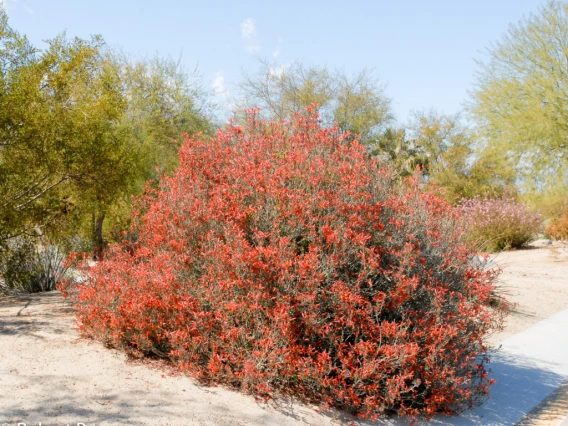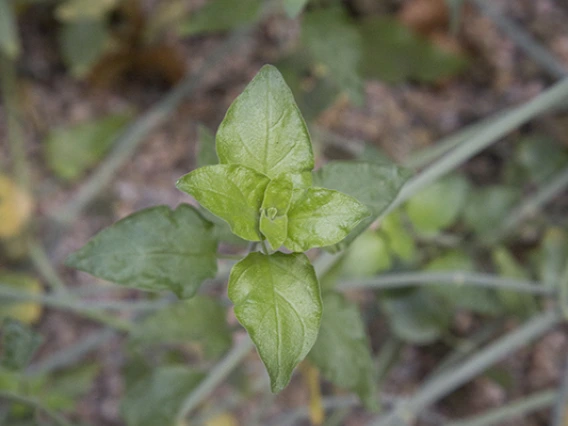


Common Names:
- English: Hummingbird Bush
- Spanish: Chuparosa
- O’odham: Vipismal Jeej
Family Name: Acanthaceae
Botanical Name: Justicia californica
Rain Garden Zone: J. californica thrives in the terrace rain garden zone. The terrace zone is typically atop a terrace or on the bank of a basin or swale. These sites have more shallow, less-frequent, and more temporary pooling than in bottom zone.

Reproduced with permission from "Rainwater Harvesting for Drylands and Beyond" by Brad Lancaster, HarvestingRainwater.com
Flowering Season: March - June
Planting Season: Monsoon
Landscape Cultivation: Chuparosa can be propagated from seed without scarification of the seed coat.
Characteristics: Chuparosa is a small shrub reaching 4 feet in height. It is generally fairly sparsely leaved or leafless, with green-white stems. Leaves are ovate and bright green. Chuparosa has bright red and orange tubular flowers in short, axillary racemes.
Ecological Benefits: Both common names for J. californica (chuparosa meaning "hummingbird" and vipismal jeej meaning "hummingbird's mother") indicate the relationship between this shrub and hummingbirds. Indeed, J. californica is a nectar-rich plant that has co-evolved with hummingbirds. The flowers are held high with the anthers positioned so that the nectar-feeding bird coats its head with pollen before taking off for the next plant. In this way, hummingbirds feast on the plant nectar while the plant can be assured of its pollination.
Practical Uses:
- Food - Because of the nectar-rich flowers, this shrub has traditionally been eaten much like honeysuckle--the nectar can be sucked from the flowers.
- Domestic Animals: Honeybees may drink the nectar of Chuparosa and produce sweet honey.
References:
- https://www.wildflower.org/plants/result.php?id_plant=juca8
- Desert Harvesters. (2018). Eat mesquite and more: a cookbook for Sonoran desert foods and living. Tucson, AZ. RainSource Press.
- Hodgson, W. C. (2001). Food plants of the Sonoran desert. Tucson, AZ. University of Arizona Press.
- Lancaster, B. (2019) Rainwater harvesting for drylands and beyond, 3rd edition. Tucson, AZ. RainSource Press.
- Little, E. L. (1980). The Audubon Society field guide to North American trees, western region. Alfred A. Knopf.
- Rea, Amadeo M. (1997). At The Desert's Green Edge - An Ethnobotany of the Gila River Pima. Tucson, AZ. Univeristy of Arizona Press.
For more information on this plant, see the Campus Arboretum species description pages.
Go to the next tour stop: velvet mesquite page or Return to the main Dunbar Spring tour page

